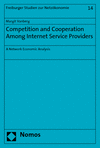Zusammenfassung
Die Konvergenz der Netztechnologien, die dem Internet, der Telekommunikation und dem Kabelfernsehen zu Grunde liegen, wird die Regulierung dieser Märkte grundlegend verändern. In den sogenannten Next Generation Networks werden auch Sprache und Fernsehinhalte über die IP-Technologie des Internets transportiert. Mit den Methoden der angewandten Mikroökonomie untersucht die vorliegende Arbeit, ob eine ex-ante sektorspezifische Regulierung auf den Märkten für Internetdienste wettbewerbsökonomisch begründet ist. Im Mittelpunkt der Analyse stehen die Größen- und Verbundvorteile, die beim Aufbau von Netzinfrastrukturen entstehen, sowie die Netzexternalitäten, die im Internet eine bedeutende Rolle spielen. Die Autorin kommt zu dem Ergebnis, dass in den Kernmärkten der Internet Service Provider keine monopolistischen Engpassbereiche vorliegen, welche eine sektor-spezifische Regulierung notwendig machen würden. Der funktionsfähige Wettbewerb zwischen den ISP setzt jedoch regulierten, diskriminierungsfreien Zugang zu den verbleibenden monopolistischen Engpassbereichen im vorgelagerten Markt für lokale Netzinfrastruktur voraus. Die Untersuchung zeigt den notwendigen Regulierungsumfang in der Internet-Peripherie auf und vergleicht diesen mit der aktuellen Regulierungspraxis auf den Telekommunikationsmärkten in den Vereinigten Staaten und in Europa. Sie richtet sich sowohl an die Praxis (Netzbetreiber, Regulierer und Kartellämter) als auch an die Wissenschaft.
Abstract
Die Konvergenz der Netztechnologien, die dem Internet, der Telekommunikation und dem Kabelfernsehen zu Grunde liegen, wird die Regulierung dieser Märkte grundlegend verändern. In den sogenannten Next Generation Networks werden auch Sprache und Fernsehinhalte über die IP-Technologie des Internets transportiert. Mit den Methoden der angewandten Mikroökonomie untersucht die vorliegende Arbeit, ob eine ex-ante sektorspezifische Regulierung auf den Märkten für Internetdienste wettbewerbsökonomisch begründet ist. Im Mittelpunkt der Analyse stehen die Größen- und Verbundvorteile, die beim Aufbau von Netzinfrastrukturen entstehen, sowie die Netzexternalitäten, die im Internet eine bedeutende Rolle spielen. Die Autorin kommt zu dem Ergebnis, dass in den Kernmärkten der Internet Service Provider keine monopolistischen Engpassbereiche vorliegen, welche eine sektor-spezifische Regulierung notwendig machen würden. Der funktionsfähige Wettbewerb zwischen den ISP setzt jedoch regulierten, diskriminierungsfreien Zugang zu den verbleibenden monopolistischen Engpassbereichen im vorgelagerten Markt für lokale Netzinfrastruktur voraus. Die Untersuchung zeigt den notwendigen Regulierungsumfang in der Internet-Peripherie auf und vergleicht diesen mit der aktuellen Regulierungspraxis auf den Telekommunikationsmärkten in den Vereinigten Staaten und in Europa. Sie richtet sich sowohl an die Praxis (Netzbetreiber, Regulierer und Kartellämter) als auch an die Wissenschaft.
- 17–23 1 Introduction 17–23
- 32–33 2.4 Conclusions 32–33
- 61–61 3.6 Conclusions 61–61
- 74–75 4.6 Conclusions 74–75
- 89–89 5.6 Conclusions 89–89
- 114–114 6.4 Conclusions 114–114
- 134–143 8 Policy conclusions 134–143
- 142–143 8.4 Conclusions 142–143
- 167–171 10 Summary 167–171
- 172–176 Appendix 172–176
- 177–184 References 177–184
- 185–187 Index 185–187

